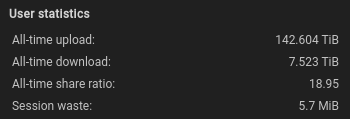- 0 Posts
- 11 Comments

 12·1 month ago
12·1 month agoYou’re not wrong, but it bugs me when my ratio drops, so I always seed everything I download. I have a pretty good internet service though.
My stats:


 1·2 months ago
1·2 months agodeleted by creator
Linux uses 8 spaces. Excerpt from the official style guide:
Tabs are 8 characters, and thus indentations are also 8 characters. There are heretic movements that try to make indentations 4 (or even 2!) characters deep, and that is akin to trying to define the value of PI to be 3.
Rationale: The whole idea behind indentation is to clearly define where a block of control starts and ends. Especially when you’ve been looking at your screen for 20 straight hours, you’ll find it a lot easier to see how the indentation works if you have large indentations.
Now, some people will claim that having 8-character indentations makes the code move too far to the right, and makes it hard to read on a 80-character terminal screen. The answer to that is that if you need more than 3 levels of indentation, you’re screwed anyway, and should fix your program.
In short, 8-char indents make things easier to read, and have the added benefit of warning you when you’re nesting your functions too deep. Heed that warning.
The reasoning seems sound, but I still prefer 4 personally.

 1·5 months ago
1·5 months agoOof, that’s annoying.
Weird that
:syntax offdoesn’t work, from a small test it seems to do the trick for me. But I guess as long as vim works there’s no need to replace it 🙂

 2·5 months ago
2·5 months agoTry running this:
:set indentexpr=and then:set noautoindent. Without any config file, this works for me while in a makefile that looks like this:foo: foo.c bar.h $(CC) $< -o $@The
indentexproption is set by filetype, but disabling filetype indent after already opening a makefile is too late, it would need to happen before opening it (in either a config file or directly after runningnvimwithout any file specified).However,
indentexprseems to only control the automatic indentation when hitting enter at the target line, but not within the recipe for it. To fix that I also had to disableautoindent.

 3·5 months ago
3·5 months agoAh dang, you’re right, I must have read it too quickly. Yeah then I also think it’s something about not loading the config, it can be investigated by checking the runtime values like I described in my second edit.

 5·5 months ago
5·5 months agoUsing a the ubuntu 24.04 docker image for testing, I was able to disable automatic indentation with this config in
~/.config/nvim/init.lua:vim.cmd("filetype indent off")If you prefer using
vimsyntax it would instead be the following in~/.config/nvim/init.vim:filetype indent offNote: it seems this file is not loaded if a init.lua file is present in that directory
Edit to add: So the reason this is required is, similar to vim (so you may already be familiar with this), there are filetype-specific configurations loaded. These usually reside in
/usr/share/nvim/runtime/<plugin/indent/syntax/etc>/<filetype>. You can configure what files to load using the:filetypecommand.There’s more info here: https://neovim.io/doc/user/filetype.html
Second edit: Also when filetype indent/plugin/syntax is on, it seems to be loaded after your user config, so it overrides it. You can investigate if your actual config was applied or not by running, for example,
:set autoindent?or:set cindent?. If the values do not match your configuration, it was likely overridden by:filetype. This was the case for me.

 1·5 months ago
1·5 months agoGotcha. That’s actually good because it will be easier to troubleshoot. I will try to reproduce in a barebones config and see if I can figure something out. What language are you editing, and what version of neovim do you use? Distro may also be relevant in case they package some indent.vim file(s).

 6·5 months ago
6·5 months agoAre you using treesitter? I think that has an option to handle indentation, but I’m not sure if it’s enabled by default.

 1·5 months ago
1·5 months agoHow did you install neovim? If you installed from source, double check that you followed the instructions, i.e. install build dependencies and then run:
make CMAKE_BUILD_TYPE=RelWithDebInfo sudo make installAlso, double check the version of nvim in your PATH matches:
nvim --version


Codeberg looks pretty good at a quick glance.